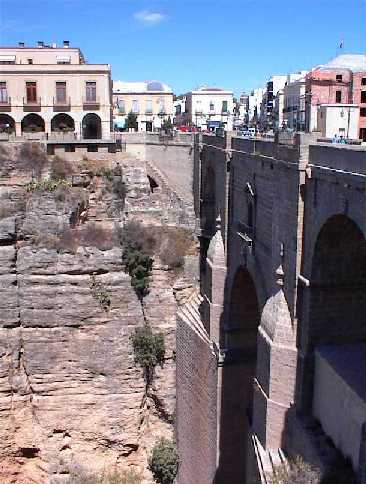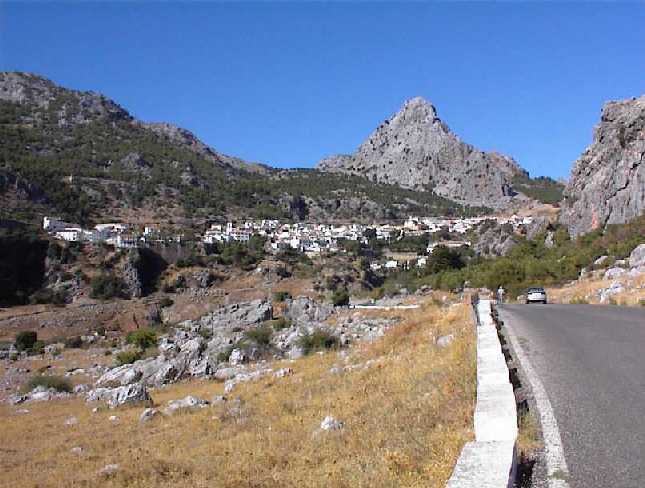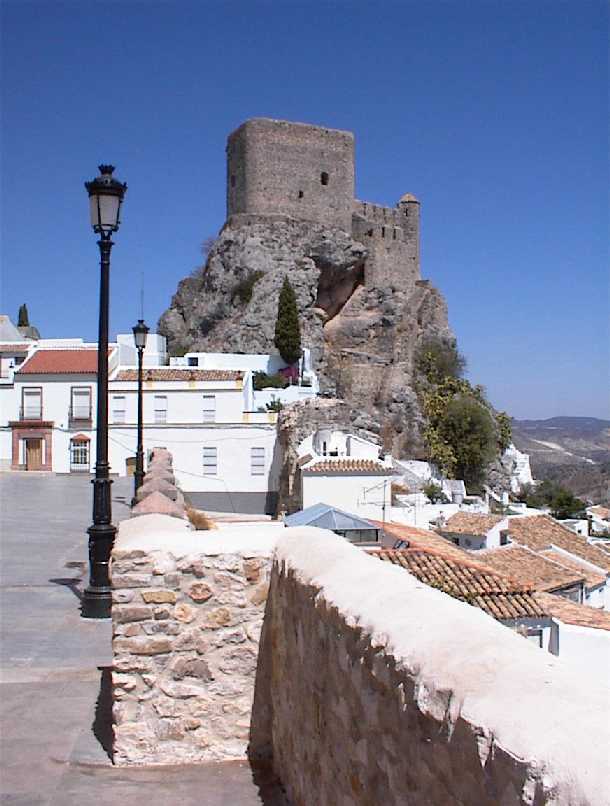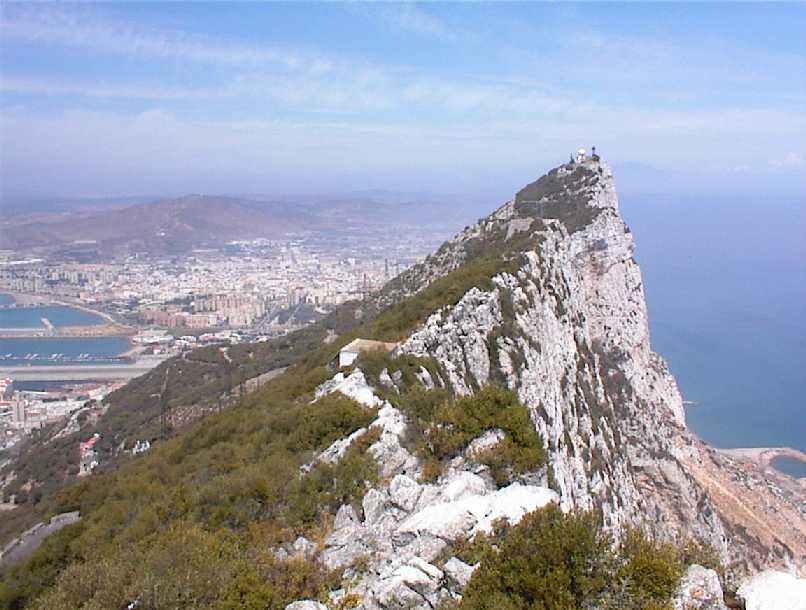Saturday 28 August 1999
We depart from Rotterdam Airport with Transavia Airlines for Malaga. The flight has been delayed by one hour. Around 7:15pm we're airborn and on our way. The flight takes about 3 hours and we land at Malaga around 10pm. It takes quite some time for our luggage to emerge from the conveyor belt. We're glad that we rented our car with Hertz instead of Avis, because there is a 50 yard's queue in front of the AVIS desk, whereas we get instant service. Our rental turns out to be a Renault Mégane. We drive into Malaga's city centre in search of the hotel we have booked. Our first experience with Spanish signposting is not very good - it is a bit of a puzzle. At last we do find the hotel. Hotel Carlos V is simple and rather noisy. After having installed our gear in the room we go out and have a drink in the pub around the corner. With a bit of tapas (Spanish snacks) we enjoy our first warm evening in Spain.
Sunday 28 August 1999
We have breakfast in a café
further down the street. When we walk back we're treated to a procession. An
enourmous crowd preceeds a large statue of the Virgin Mary carried by group of
musclled lads. The vicar leads crowd in a song with the help of a megaphone.
After this display we get on our way to Ronda. Again the
idiosyncratic signposting plays tricks on us, in our attempt to leave the city.
But we manage to find our way and soon we find ourselves in a impressive
mountain range: the Sierra de la Nieve. De roads through the mountains quiet and
winding. In Ronda we find a hotel across from the Alameda park (almost every
self respecting town in Andalucia has a Alameda, as it turns out).We head for
the city centre, situated beautifully on a mountain plateau. The plateau is cut
in two by a canyon. A bridges connects both sides of town. Because of the heat
(temperatures soaring to 35°
C or 95° F)
we cut short our sightseeing and go for lunch at the Parador of Ronda. A Parador
is a typical Spanish phenomenon. These are historical buildings like castles,
palaces, monasteries or stately homes converted into four or five star hotels.  .
Each of them is superblly located and have, although fitted with all modern
comforts, retained their historic character. The
Paradors
chain was started on an initiative of king Alfonso XIII in 1928 and cover most
parts of Spain. A few are housed in modern buildings, however. Ronda's Parador
is a gem too. Housed in the former Town Hall it is perched on the edge of the
canyon. The view is magnificent. After lunch we retire for a siesta. Something
we intend to do every day for the rest of our stay in Spain. After our rest we
have some tapas on the Plaza del Socorro. This square is lined with café's,
bars and restaurants. Around nine we have dinner in Restaurant Don Miguel. The
beautiful setting at the canyon's edge has to make up for the sometimes
questionable quality of the food.
.
Each of them is superblly located and have, although fitted with all modern
comforts, retained their historic character. The
Paradors
chain was started on an initiative of king Alfonso XIII in 1928 and cover most
parts of Spain. A few are housed in modern buildings, however. Ronda's Parador
is a gem too. Housed in the former Town Hall it is perched on the edge of the
canyon. The view is magnificent. After lunch we retire for a siesta. Something
we intend to do every day for the rest of our stay in Spain. After our rest we
have some tapas on the Plaza del Socorro. This square is lined with café's,
bars and restaurants. Around nine we have dinner in Restaurant Don Miguel. The
beautiful setting at the canyon's edge has to make up for the sometimes
questionable quality of the food.
Monday 30 August 1999
We oversleep a little (was it last night's
delicious wine?) and get up at nine. After breakfast we go on a drive around
Ronda visiting some "White villages". We drive into the Sierra de
Grazalema, a Natural Park. We first get the village of Grazalema, the centre of
the Park. It is a nice little town with a pretty square and church. We move on
to El Bosque (another village like that) on again to Zahara de la Sierra. Zahara
seems to have been splashed on to the mountains when viewed from a distance.  It
lies at the foot of a Moorish fortress. Back in 1983 it was declared a national
monument. We stop for lunch in restaurant Tadeos. A bit out of the way and
seemingly deserted. Mother and son run the place and serve a good meal. Erik has
his first plate of Gazpacho of this trip - many more will follow. Algodonales is
the next stop. The central square and the church are worth seeing. By this time
it so hot that exploring the village does not seem an option. We move on to
Olvera. From a distance we can admire its location. It looks as if it has been
splashed against the mountain wall.
It
lies at the foot of a Moorish fortress. Back in 1983 it was declared a national
monument. We stop for lunch in restaurant Tadeos. A bit out of the way and
seemingly deserted. Mother and son run the place and serve a good meal. Erik has
his first plate of Gazpacho of this trip - many more will follow. Algodonales is
the next stop. The central square and the church are worth seeing. By this time
it so hot that exploring the village does not seem an option. We move on to
Olvera. From a distance we can admire its location. It looks as if it has been
splashed against the mountain wall. . The church and the moorish castle are on a hilltop. From there we have a
marvellous view over the area. Via Setenil de las Bodegas we drive back to
Ronda. Early evening we 're surprised by a parade of participants in an
international folklore festival, marching past our hotel. Dance groups from all
over the world show their skills on the street. We have dinner on the terrace of
restaurant Jérez opposite the Bullfighting ring. After that we take a
"capuchino" at a side walk café. It turns out to be a huge amount of
whipped cream, with a bit of coffee hidden underneath.
. The church and the moorish castle are on a hilltop. From there we have a
marvellous view over the area. Via Setenil de las Bodegas we drive back to
Ronda. Early evening we 're surprised by a parade of participants in an
international folklore festival, marching past our hotel. Dance groups from all
over the world show their skills on the street. We have dinner on the terrace of
restaurant Jérez opposite the Bullfighting ring. After that we take a
"capuchino" at a side walk café. It turns out to be a huge amount of
whipped cream, with a bit of coffee hidden underneath.
Tuesday 31 August 1999
Today we head on to Gibraltar.
The road down south out of Ronda takes us a beautiful mountain range. As we have
read that accommodation in Gibraltar itself is heavily overpriced, we look for a
place to sleep in La Línea, the Spanish town that borders on Gibraltar. La
Linea is a quite an eye sore and a bit of endurance test for finding appropriate
accommodation. In the end we do find a reasonable pension (Hostal La Campana)
not even 800 yards from the border crossing. We walk into Gibraltar. You can
take your car into Gibraltar, but involves waiting in a mile long queue. Across the border
we hop on a double decker bus, which takes up to Main Street. Before we get
there the bus has to cross runway of Gibraltar Airport. Gibraltar is very
touristy. Apart from tourists its visited by Spaniards and by British with a
second home on the Costa del Sol. They come here to do there shopping.
Especially cigarettes and liquor are good buys. But for the Brits the main
attraction lies in the British retail chains who have their stores here
(Marks&Spencer, Safeway, Bhs, etc.) and where they can stock up on their
marmalade, white beans in tomato sauce and ladies' underwear. After an English
pub lunch we head for the real sights of Gibraltar. We take the cable car up the
rock. Here it becomes clear why Britain has held onto the Rock over the
centuries. From the rock the entrance to the Mediteranean Sea is easily
controlled. We can see the Maroccan coastline in not so far in the distance. The
view is breath taking. The view also reveals how small Gibraltar really is, and
how densely populated.
car into Gibraltar, but involves waiting in a mile long queue. Across the border
we hop on a double decker bus, which takes up to Main Street. Before we get
there the bus has to cross runway of Gibraltar Airport. Gibraltar is very
touristy. Apart from tourists its visited by Spaniards and by British with a
second home on the Costa del Sol. They come here to do there shopping.
Especially cigarettes and liquor are good buys. But for the Brits the main
attraction lies in the British retail chains who have their stores here
(Marks&Spencer, Safeway, Bhs, etc.) and where they can stock up on their
marmalade, white beans in tomato sauce and ladies' underwear. After an English
pub lunch we head for the real sights of Gibraltar. We take the cable car up the
rock. Here it becomes clear why Britain has held onto the Rock over the
centuries. From the rock the entrance to the Mediteranean Sea is easily
controlled. We can see the Maroccan coastline in not so far in the distance. The
view is breath taking. The view also reveals how small Gibraltar really is, and
how densely populated.  .
From the top we begin with our descent by foot. We pass St Michaels cave, a
natural cave. After that we get to the Ape's Den, where a group of Barbary Apes
has its habitat. They are the only wild monkeys in Europe. They are, however,
being fed and watched by the British Army. The monkeys have not much of a
territorium to gather food and to prevent them from roving the town for food,
the food is brought to them in order to keep them where they are. Another reason
is the superstitious believe that as long as the monkeys live on the Rock, it
will remain British. The monkeys are not shy at all. They jump on passing cars
and reportedly snatch handbags and camera's off unsuspecting tourists, only to
toss them down the rock.
.
From the top we begin with our descent by foot. We pass St Michaels cave, a
natural cave. After that we get to the Ape's Den, where a group of Barbary Apes
has its habitat. They are the only wild monkeys in Europe. They are, however,
being fed and watched by the British Army. The monkeys have not much of a
territorium to gather food and to prevent them from roving the town for food,
the food is brought to them in order to keep them where they are. Another reason
is the superstitious believe that as long as the monkeys live on the Rock, it
will remain British. The monkeys are not shy at all. They jump on passing cars
and reportedly snatch handbags and camera's off unsuspecting tourists, only to
toss them down the rock.
Back in La Línea, we treat ourselves to a lovely Paella. In the couse of the evening it gets colder and quite foggy.
Woensdag 1 september 1999
We drive on to Tarifa. It is but a small town on the Costa de la Luz. This Costa runs roughly from Algeciras to Cádiz and has relatively quiet and broad sandy beaches. The water is a bit on the cool side. This is not the Med, but the Atlantic. Tarifa is especially sought out by windsurfers, because of the unrelenting sea wind. We find a room in the Hostal Alameda, over the restaurant by the same name. Centrally located and fairly good. The town is not a real sight, but has some nice side walk café's. The beach is the real attraction. And that's where we are headed this afternoon.
We spend part of the evening having dinner at Taberna San Mateo, run by Germans, serving a good meal.